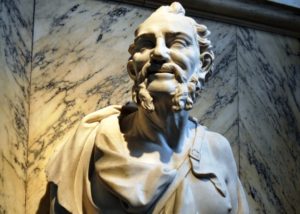 Democritus (c. 460 BCE – c. 370 BCE) was a pre-Socratic Ancient Greek philosopher who explained about composition of matter. He also pioneered the concept of atoms which spurred the evolution of atomic theories. As a result, more and more atomic theories came up from different scientists from time to time until the proposal of modern atomic theory which is more perfect with the support of experimental evidence. Read also: Democritus Theory of Atoms
Democritus (c. 460 BCE – c. 370 BCE) was a pre-Socratic Ancient Greek philosopher who explained about composition of matter. He also pioneered the concept of atoms which spurred the evolution of atomic theories. As a result, more and more atomic theories came up from different scientists from time to time until the proposal of modern atomic theory which is more perfect with the support of experimental evidence. Read also: Democritus Theory of Atoms
Democritus took the name of “atom” from the Greek language (the prefix a means not and the word tomos means cut) which means the composition of matter that’s uncuttable and invisible (can’t be seen). Democritus got his thoughts about atom from his teacher, Leucippus, who was a pre-Socratic Ancient Greek philosopher.
Atom According to Democritus
Democritus and his teacher, Leucippus, stated that atoms were the smallest form of elements that formed reality. Democritus and Leucippus’ statement agreed the Empedocles and Anaxagoras pluralism teachings that stated reality consisted from various elements, not just consisted by only one element. But later opposed with the statement by Democritus that said forms of elements that’s uncuttable were considered as atoms.
Democritus’ statement was based on his mere observation that was inspired by the sand particles that formed the beach. Democritus analogized the sand as the atoms and the beach as the compounds. His point was that even though beach could be divided into sand particles, the sand itself couldn’t be divided anymore by plain view. According to him, atoms were fully solid that had no internal structures. His thoughts also explained that had to be a void or an empty space for movement of the atom. Democritus’ atomic model explained that all matters were made up of some extremely small structures called the atoms. Read also: Chemistry Models of Atoms
The existence of atoms in the universe was infinite and each atom had their own unique traits and characteristics. For example, the atoms in the water would act differently from those atoms that are in the wood. Even though it can’t be proven by experiment, only later in the 1800s that there’s an experimental evidence spurred by Democritus’ statement.
Atom theory according to Democritus:
- Atom is the smallest form of elements that form reality
- It can’t be seen by plain view because of the extremely small size
- Atom has no quality, but it has quantity and mass number
- Atom can be differed by its shape and portion
- The number of atoms that formed reality is infinite
- Atom can’t be altered nor annihilated
- The principle of the universe is atom and there’s an atomic vacuum that is analogized with the sand particles as explained above. It is also explained with the situation of sunshine enters a dark room through windows’ crack so that the dust moved
- Atoms’ movement is caused by a void or an empty space.
Read also:
Drawbacks of Democritus Atomic Theory
- This theory is solely based on reasonings with no experimental evidence or scientific proof to support the theory itself
- The definition given by Democritus is too general
- The Aristoteles atomic model system explanation is easier to understand than Democritus’ explanation which is too general. As a result, Democritus’ concept about atom is rejected.
That’s the drawbacks of Democritus atomic theory.
Relation Between Atom and Another Aspects According to Democritus
- About World: Reality in this world is caused by different atoms linked between one specific atom to one another. Atoms will move around forming a big collection of atoms with the largest atom located in the middle as the center and the softest atoms located at the tip. Therefore, the world is created.
- About Human: Democritus also thought that there is a correlation between atoms and human. He imagined that human beings consist by atoms with human soul as the soft atom which is moved by eidola in the form of small pictures over objects. As a result, sensory impressions over objects emerged.
- About Identification:Democritus stated that atoms don’t have quality. Quality can only be felt because there is a contact between one atom specific with another atom. As an example, the sweet taste that we felt is caused by the soul atom with the slippery atom. The bitter taste that we felt is caused if the soul atom touched the rough atom. The heat that we felt is caused if the soul atom touched an atom that moved in a very high speed. So, Democritus thought that human’s quality is not its true state but only felt by the subject. Because in a matter of fact humans can only observe sightings and phenomenon of an object without really knowing the nature of the object itself.
- About Ethics:Democritus stated that the highest value of human life is a perfect inner state (euthymia). Perfection is created if there is a balance of happiness and sorrow, and joy and trial for every factor of life which is polished by rational sense.
Read also: Advantages and Disadvantages of Dalton’s Atomic Theory
Other than atoms, Democritus also had already made many works regarding science, universe, mathematics, literature, and engineering. As the pioneer of the early atomic theories, his work is very appreciated today even though his concepts were highly rejected back in his era by two scientists (Plato and Aristoteles) the drawbacks of the atomic theory that Democritus proposed.
In the end, after the 1800s, there was several people who were interested to make a more precise experiment pioneered by John Dalton. Dalton came up with his Dalton atomic theory which is supported by evidence and experiment which later improved until the modern atomic theory proposed.
Thereby an explanation about atoms viewed in the point of view of a scientist named Democritus from Greece. Hopefully this article can open our perception and knowledge about atoms and could improve our perception so that we can make a better development of atomic theories from time to time.

